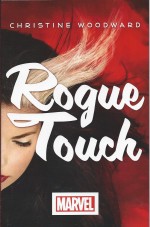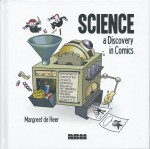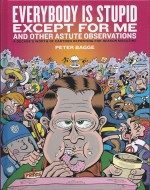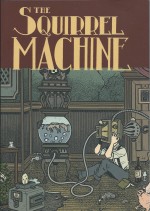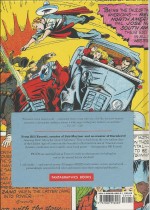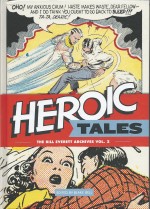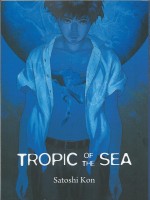
By Satoshi Kon, translated by Maya Rosewood (Vertical)
ISBN: 978-1-939130-06-8
In the West we’re used to single manga stories filling entire bookcases: epic sagas filling thousands of pages with brilliant, lovely, exciting but generally very long tales on every theme and subject under the sun.
Every so often, however, something comes along which is more familiar to English sensibilities, such as this short, sharp, sinister shocker from screenwriter, artist, animator and Director Satoshi Kon.
The author was born in Kushiro Subprefecture, Hokkaido in 1963 and after High School attended MusashinoArtUniversity’s Graphic Design department from 1982-1987. Whilst there he spent a lot of time studying foreign film.
Whilst still a student he released the short manga Toriko and became an assistant to Katsuhiro Otomo, dividing his time between comics and animation. In 1990 he produced the single volume Kaikisen we’re concentrating on here, before graduating more fully toward film as scripter, layout artist and animator.
Amongst his credits are World Apartment Horror, Roujin Z, Patlabor 2: The Movie, Magnetic Rose, Perfect Blue Millennium Actress, Tokyo Godfathers and others. What would have certainly been a stellar career in either or both art forms was cruelly cut short in 2010 when he died tragically young from pancreatic cancer.
As Shinsouban Kaikisen, this eerie yarn was first serialised in Kodansha’s Young Magazine in 1990: eleven episodes between issues #17 and 29, thereafter collected in tankÅbon form and again as a Bijutsu Shuppan edition in 1999. That commemorative tome provides the informative Afterword which ends this book describing the author’s path from mangaka to animator.
Tropic of the Sea opens on a secluded beach where teenager Yosuke and his dog Fujimaru play before the dutiful son climbs to a hilltop shrine to enact a centuries-old ritual. His joyful morning is then disturbed when his father brings a TV crew into the sacred area.
Yozo Yashiro is the 23rd Head Priest of the Hiratsu Shrine; a thoroughly modern man keenly supporting a major consortium’s ambitious plans to turn the sleepy fishing village of Ade into a modern luxury resort. As such he’s keen on publicity and is happy to disturb the Mermaid’s Egg within the shrine and show it to all the viewers whilst explaining the silly but charming legend attached to it.
Long ago his ancestor found another such egg and promised a mermaid to respectfully care for it. After six decades the egg was returned to the sea and another egg left. In return the sea matron guaranteed calm waters and abundant fishing. This current egg was deposited in the shrine almost exactly sixty years ago…
The televised lecture is interrupted by Yosuke’s furious grandfather who has dragged himself out of hospital to stop the travesty he has just seen. Again the bitter argument begins. Grandfather is a fierce opponent of the proposed resort, whereas the current priest is no believer in his duties, nor the sacrosanct pact between the fishermen and the nonsensical sea-woman.
He does however realise the tourist potential of a Mermaid’s Egg theme park…
The village too is divided into warring camps on the issue. The fishermen see their ancestral livelihoods threatened by the proposed tourist trap whilst shopkeepers imagine thousands of new customers flocking in daily.
As Yosuke and best buddy Tetsu discuss the potential influx of college girls and summer days, they watch a limousine full of Ozaki Construction bigwigs arrive to inspect the monstrous Hotel growing like a giant tumour on the beach, and feel a pang of apprehension…
The egg is now common knowledge and billboards proclaiming “Welcome to Mermaid Country†are everywhere, but the boys’ minds are on more mundane things… but only until they take a dinghy out to the sacrosanct offshore islet Kamijima and catch a tantalising glimpse of something impossible in the water…
It turns out to be only old school friend Nami, back from Tokyo for the summer mermaid festival and taking a playful swim, but Yosuke is still uneasy and oddly unsettled…
With Ade becoming a bustling, money-mad boomtown and the priestly Yozo vigorously pushing villagers into selling their land to the developers, grandfather – despite his illness – is determined to honour the family’s ancient promise, and things take a decidedly dark turn when ambitious corporate development head Kenji Ozaki starts taking an unhealthy interest in the Egg. He also lets slip that Kamijimi will be razed and turned into Marine Land theme park…
He’s too late: by the time his team get to the hilltop shrine the Mermaid’s treasure has vanished. The trail leads to Kamijima where Nami and the boys find grandpa with the Egg in a submerged grotto. It’s the place where the mermaid has come every sixty years to pick up her hatchling and leave a new egg and grandpa has almost killed himself getting it here. Hard on the kids’ heels, however, come Ozaki and his goons.
As the businessman tries to appropriate the gleaming globe a strange waterspout erupts and in the tumult Yosuke badly cuts his hand. The drama soon subsides though, and as they all return to Ade in Ozaki’s launch, the boy is amazed to realise that when he picked up the Egg his wound completely healed…
There’s even stranger news to come as tensions over the Corporation’s full building schemes leak out. In the hospital the doctors cannot understand how grandpa’s terminal stomach cancer has completely gone…
Days pass and already the first wave of tourists are despoiling the previously quiet seaside atmosphere. Nami and Yosuke – no longer sceptical about the Egg – are making plans, but Ozaki is also convinced that the object has some mysterious power and takes steps to claim it for the company even as his bulldozers begin to clear Kamijima.
The fishermen are furious. Their once-abundant catches have dried up and the Mermaid’s Egg festival, crowded with suits and tourist interlopers, degenerates into a massive riot. In the melee, with Yozo’s compliance, Ozaki takes the artefact into his safekeeping, and the stunned, betrayed Yosuke thinks he sees a figure on a rock, waiting in vain for her child to be returned…
As Ozaki’s technicians poke and probe the Egg, the traditional day of surrender comes and goes. Yosuke barely survives an uncanny contact with something beyond the scope of science and, with Nami and Tetsu, determines to retrieve the Egg and return it to its true owner whatever the risk…
A tense clash on a bridge finds the kids surprisingly victorious but it’s too late. The Egg hatches in Yosuke’s hands and at the beach the sea vanishes. It can mean only one thing. A tsunami is coming: a wall of angry wild water to wipe away all the foul fabrications of double-dealing, oath-breaking mankind…
Brooding and pensive, this superb supernatural thriller builds tension with masterful dexterity in beguilingly understated style and Kon’s superb draughtsmanship and meticulous pacing keeps the suspense simmering until the spectacular denouement snatches your breath away. A cracking tale no fiction fan or comics collector should miss – especially as the book also includes a gallery of the beautiful title pages which accompanied the original Young Magazine serialisation.
Tropic of the Sea is a minor masterpiece of modern fantasy fiction and a perfect spooky epic movie in waiting…
© 2013 KON’STONE Inc. All rights reserved.
This book is printed in ‘read-from-back-to-front’ manga format.

